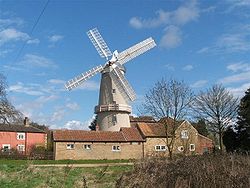- Denver Windmill
-
Denver Windmill 
The restored mill, April 2006Origin Mill name Denver Mill Grid reference TF 6050 0121 Coordinates 52°35′06″N 0°22′03″E / 52.5850°N 0.3676°ECoordinates: 52°35′06″N 0°22′03″E / 52.5850°N 0.3676°E Operator(s) Denver Windmill Ltd Year built 1835 Information Purpose Corn mill Type Tower mill Storeys Six storeys Number of sails Four sails Type of sails Double Patent sails Windshaft Cast iron Winding Fantail Fantail blades Six blades Auxiliary power Steam engine, later replaced by a diesel engine Number of pairs of millstones Three pairs Denver Windmill is a Grade II* listed[1] tower mill at Denver, Norfolk, England which has been restored to full working order.
Contents
History
Denver windmill was built in 1835, replacing an earlier post mill which was marked on the 1824 Ordnance Survey map.[2] The mill was built for John Porter and the tower bears a place with the legend JMP 1835. A steam mill had been erected at Denver windmill by 1863, powered by a 12 horsepower (8.9 kW) engine. This drove three pairs of millstones, as did the windmill.[3]
In 1896, James Gleaves made a Deed of Assignment and the mill was offered for sale by auction at the Crown Hotel, Downham Market but was withdrawn from sale at the auction.[3] The mill was later bought by Thomas Harris, who had previously run the post mill at Southery.[2] On 22 February 1908, the mill was damaged in a gale and put out of action. Thomas Harris died in 1925 and left the mill to his son Thomas, who continued to work it by wind and a diesel engine, which had replaced the earlier steam engine.[3] The mill's centenary was celebrated with a supper on 10 January 1936. In December 1937, Thomas Harris was awarded a certificate by the Society for the Protection of Ancient Buildings. The mill was struck by lightning in 1939 and a sail was damaged, but this was repaired. In 1941, the curb was damaged, ending the use of wind power.[2] Milling continued by a Blackstone diesel engine until 1969 when Thomas Harris died. The mill passed to his sister, Edith Staines, who offered the mill to Norfolk County Council on condition that they covered the legal fees.[3] In July 1972, a sail was blown off in a gale, damaging the stage as it fell. The opposite sail was removed leaving the mill with a single pair of sails.[2] The Deed of Gift was signed on 20 August 1973.[3] Restoration work to the cap, gallery, sails and fantail was carried out by millwrights John Lawn and Philip Lennard in the winter of 1974-75.[2]
On 2 January 1976, the cap was lifted during a gale, and damaged the curb and supporting brickwork.[4] The cap was eventually removed for restoration work to be carried out in 1991 and in 1992 further work was carried out on the sails.[citation needed]
In 1995, the Mill House was put up for sale, and purchased by the Norfolk Historic Buildings Trust. The mill was sold by Norfolk County Council to the Norfolk Historic Building Trust at this time. Restoration work to restore the mill to full working order was carried out at a cost of over £1,000,000. This was partly funded by grants from the European Regional Development Fund, the Heritage Lottery Fund, Norfolk County Council and the Rural Development Commission and a loan from the Architectural Heritage Fund. The restored mill opened to the public in March 2000.[5] On 4 October 2011, a sail fell from the mill, damaging another and landing 6 feet (1.8 m) away from a group of pupils from Clenchwarton Primary School, who were visiting the mill at the time.[6]
Description
For an explanation of the various items of machinery, see Mill machinery.Denver Windmill is a six storey tower mill with a stage at third floor level. The tower is 59 feet (17.98 m) high to the curb. The ogee cap has a gallery and is winded by a fantail. The mill drives three pairs of overdrift millstones.[3] A 1932 Blackstone diesel engine provides auxiliary power.[7]
Millers
- John Porter 1835-53
- John Gleaves 1853-73
- James Gleaves 1873-96
- Thomas Edward Harris 1896-1925
- Thomas Edwin Harris 1925-69
Reference for above:-[3]
Public access
Denver Windmill is open to the public from 10:00 to 17:00 daily, except Christmas Day.[8]
Culture and media
Denver Windmill appeared in an episode of 'Allo 'Allo titled Fighting with Windmills which was filmed in 1992.[9]
External links
- Windmill World webpage on Denver Windmill
References
- ^ "WINDMILL IN SLUICE ROAD, DENVER, KINGS LYNN AND WEST NORFOLK, NORFOLK". English Heritage. http://www.imagesofengland.org.uk/details/default.aspx?id=221454. Retrieved 9 July 2009.
- ^ a b c d e Brown, R J (1976). Norfolk Corn Windmills, Volume 1. London: Robert Hale. pp. p150. ISBN 0-7091-5641-3.
- ^ a b c d e f g Apling, Harry (1984). Norfolk Corn Windmills, Volume 1. Norwich: The Norfolk Windmills Trust. pp. p33–36. ISBN 0-9509793-0-9.
- ^ "Denver towermill". Norfolk Mills. http://www.norfolkmills.co.uk/Windmills/denver-towermill.html. Retrieved 9 July 2009.
- ^ "Past Projects, Denver Mill Complex". Norfolk Historic Buildings Trust. http://www.norfolkhistoricbuildingstrust.org.uk/projects/past/025_denver_mill.htm. Retrieved 9 July 2009.
- ^ "Denver Mill sail falls near Norfolk school pupils". BBC News Online. 5 October 2011. http://www.bbc.co.uk/news/uk-england-norfolk-15179697. Retrieved 6 October 2011.
- ^ "Denver Windmill". Denver Windmill Ltd. http://www.denverwindmill.co.uk/. Retrieved 9 July 2009.
- ^ "Denver Windmill". SPAB. http://www.nationalmillsweekend.co.uk/pages_wind/denver.htm. Retrieved 9 July 2009.
- ^ "Windmills and Watermills as stars of TV and film". Windmill World. http://www.windmillworld.com/mills/stars.htm. Retrieved 19 July 2008.
Categories:- Windmills in Norfolk
- Museums in Norfolk
- Mill museums in England
- Buildings and structures in Norfolk
- Tower mills
- Grinding mills
- Buildings and structures completed in 1835
- King's Lynn and West Norfolk
- Grade II* listed buildings in Norfolk
- Grade II* listed windmills
Wikimedia Foundation. 2010.

